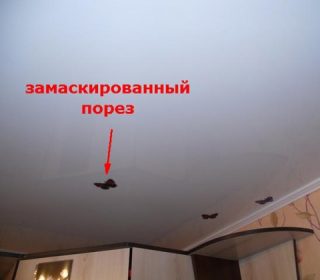In the decoration of houses and apartments, the use of stretch ceilings is becoming one of the most popular options. This method allows you to mask irregularities, unsuccessful painting, cracks, traces of leaks. Drywall cannot give such an effect. After two to three years of use, the material begins to crumble at the joints of the sheets. Problems arise when the building shrinks, cracks may appear on the surface of the drywall because of this.
Causes of damage
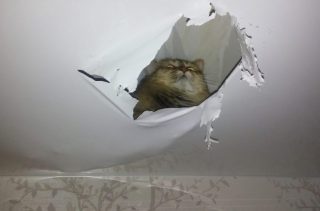
Cracks and tears in a stretch ceiling appear against a background of various factors.
- Damage resulting from the installation of cornices under window openings. Sharp elements tear the thin film during careless movement. To avoid such a situation, the edges of the cornices should be wrapped with soft rags.
- Violations of installation rules. Foil ceilings are installed using a welded seam. The width of the canvas does not allow them to be placed in a single fabric over the entire area of the room. During operation, the seam may come apart. This defect resembles a cut in size and appearance. The weld is torn if a large amount of water has accumulated as a result of flooding.
- Active games of children, which lead to the formation of mechanical damage. In rooms where there is a risk of frequent hitting the ceiling of balls or sharp toys that can tear the canvas, it is best to install fabric materials. They are more resistant to impact than film.
- Tearing off the harpoon. A defect that looks like a cut appears if a harpoon comes off on the PVC coating. In such a situation, the web bursts in the place where the element is welded.
The repair methods are the same regardless of the cause of the damage.
Defect elimination methods
There are several options for sealing a hole in the canvas.
Sew up the hole

Fabric ceilings are considered the most durable and resistant to damage. You can fill in the holes that appear in such a material in any way that is suitable for vinyl. One proven and effective option is stitching.
This is best used if the cut is straight and small.
To repair the coating, you need to prepare nylon threads to match the color of the fabric. The stitches must be applied very carefully so as not to damage the material.
The patched sections along the wall and in the corners will remain invisible, but if you had to sew in the center of the ceiling, you can additionally use acrylic paint for masking. It is applied with a spray bottle to the site of damage. Thus, it is possible to achieve an ideal state of appearance.
Seal the hole with a patch
The edges of the hole are tightly connected to the patch. To prevent the hole from enlarging, the fabric should not move away from the coating.
You can use the external method of gluing the patch, but it is applicable only as a draft.If a piece is glued from the outside, it is visible to the naked eye.
It is not recommended to glue pieces of a different color on a stretch ceiling. If there is no suitable canvas, you can temporarily seal the hole with transparent tape. But this option is used only to eliminate the risk of hole growth.
If you cannot find the material of the required shade, you can use another fabric, but after installation, cover it with paint to match the color of the general background.
Required tools and materials
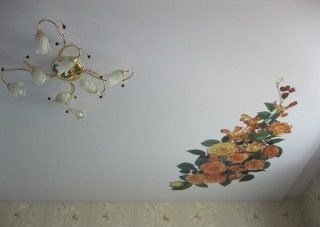
To repair a stretch ceiling with your own hands, you need to prepare the following tools:
- scissors;
- stepladder;
- a needle;
- building hair dryer - it may be required if you want to make the film more elastic for stretching;
- long handle roller;
- a spatula designed for filling the ceiling sheet into a baguette;
- container for diluting paint;
- roulette.
In addition to the basic tools, glue mixtures and materials may be required for work:
- fabric patches - cover lengths or any that match in color will do;
- nylon threads to match, they are necessary only for fabric coverings;
- water-based paint;
- glue based on cyanoacryl and special for film stretch ceilings;
- cord to strengthen the edge of the film sheet.
The choice of materials depends on what type of coating the work will be carried out.
Instructions for sealing a hole in a PVC stretch ceiling
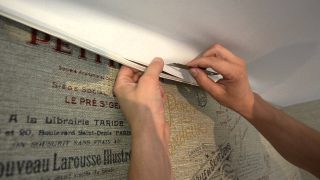
If the tension structure is made of film, the repair method will depend on the size of the cut and its location.
- If the damage is near a wall, the canvas can be stretched a lot. This method is suitable when no more than 15 cm from the hole to the wall. The defect is hidden in a baguette. To do this, you need to release a piece of coating in a small area from it. Cut off the damage with scissors. As a result, you will get a new edge, you need to attach a cord to it, wrap the film allowance and tuck it into the baguette. This will require the use of a rounded trowel and a hair dryer or heat gun to help increase the elasticity of the material. If the gap is far from the wall, use this method and do not over-pull the film. Because of this, the ceiling will deteriorate completely. Even heating the fabric before starting work will not help here.
- The place of damage, localized in the center of the canvas, can be hidden by placing a ceiling lamp, grill or ventilation diffuser on it. Before installing the device, a hole is cut in accordance with its dimensions. To prevent the film from creeping, you need to glue a thermal ring in place of the cut. The method can be used if the damaged area does not exceed the parameters of the built-in object.
- The canvas from mechanical damage or the accumulation of a large volume of water can break in the center. If the size of the defect is very large, you can hide it by gluing an applique. It is cut from color film. It turns out to eliminate the problem area of the canvas and embellish the surface a little. This is a great way to brighten up your room.
- If the harpoon has jumped out, it is inserted into the mounting profile. It is very easy to fix the problem; for this you need to use a special spatula. With its help, the canvas is refilled back. If the film has a very thin harpoon edge, the place can be sealed with a cord. In situations where it is not possible to fix the damage in this way, you will need to completely replace the wall molding.
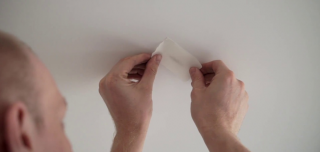
If the ceiling is newly installed and is covered by the warranty, it is not recommended to try to rectify the defect yourself. Even in the simplest cases, you need to call the master at home. In case of unauthorized repair of the structure, the company's warranty ceases to be valid. You can temporarily hide the problem area until the arrival of specialists.An adhesive tape is applied to the hole so that the hole does not increase in size, does not creep to the sides.
Stretch ceiling is a comfortable modern design, but not resistant to strong mechanical damage. Small defects can be easily eliminated in various ways on your own without dismantling the canvas.

